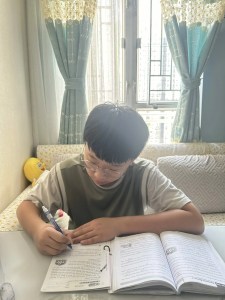Lai’s profile
School Grade: Post-secondary
Center: Kumon Sun Hing Education Centre (Hong Kong)
Subject:
Kumon Math – Completed in July, 2016 (equivalent to senior secondary school level)
From “Fail” to “Commendable”, Student Lai
We often receive parents’ inquiries about the appropriate age to start learning Kumon. We always answer, “Children over three years old can learn Kumon.” Then parents will respond, “What if my child starts in Primary 5, is it too late?”
About this question, we will have our spotlight of this interview, student Lai, who started learning Kumon Math in Primary 6, and became a Kumon completer in Secondary 3, to answer.
Building a Firm Foundation from Addition and Subtraction
When Lai was in Primary 6, she had to prepare a portfolio for secondary school admission interview. Therefore, Lai’s mother went to a photocopy shop. She chatted with the shop owner and mentioned about her worry of Lai’s math. Then the shop owner suggested, “What about letting your daughter learn Kumon? It may be helpful for her Math.” Lai’s mother had no idea about Kumon at that time; however, she thought that it was all right to give it a try if someone recommended.
Looking back, when Lai started learning Kumon, Lai still remembered clearly and said, “I was in Primary 6 and I started Kumon Math at level B, which is a very low level. To me, it was ridiculous for a Primary 6 student to start with addition and subtraction. Plus, there was homework every day and the amount of homework was quite a lot, so it was quite annoying to me. However, once I started, I found out that I even made mistakes on addition and subtraction. I felt very useless, and I was determined to fix this problem quickly. Now, I look back and I knew that I was weak at the basic part, and Kumon helped me to build a firmer foundation.
In this regard, Lai’s father added, “Learning is a process of accumulation, which needs a lot of practice, especially for math. Besides, the knowledge in math follows in a proper sequence and order; each learning part is correlated to another part. If you do not master the previous knowledge, it is no way you can continue learning. Therefore, Kumon requires children to learn every day. It is necessary to build a firm foundation and accumulate knowledge through continuous and step by step learning”
Individualized Instruction Allows Me to Think and Understand “Why”
Lai told us, “Kumon requires us to look at the example first. When I look at the example, I would think ‘I know how to do it by myself!’ if I do not get it, I need to proactively ask my instructor how to comprehend the example, instead of asking how to do. Because I did not understand what my school math teacher taught before, I often made mistakes, then I felt discouraged and became less confident in doing math. However, my Kumon instructor was very friendly and explained to me patiently, and the way she taught made me understand easily.
When I felt that I could not continue to learn Kumon anymore, like learning level D, my Kumon instructor talked to me, ‘higher level of study will be very helpful to you. Now you come to the center once a week. If you have difficulties in learning, you can come more often when you are available. If you do not know how to do, then ask me.’ Then she helped me to adjust my learning progress plan, the amount of worksheet, and assisted me in overcoming this difficulty.”
Besides helping Lai to build a solid foundation, another important reason why Kumon could help Lai’s improving her math is that Kumon instructor knows the best instruction which suits Lai. As Lai’s father said, “In my generation, our learning method was basically following teacher’s instructions, and we would not ask ‘why’; but actually children need to learn thinking, and learn to ask ‘why’.”
Realizing the True Value of Self-Learning
Going through persistent learning for seven years, Lai became a Kumon Math completer when she was in Secondary 3. At the time she was interviewed, she was already a college student. When she mentioned about the new college life, she said, “college study encourages students to learn proactively. I was used to this learning style, so now I am not afraid of that. I won’t wait passively. Instead, I will think proactively. For example, I am confident of asking questions in talks, or after I am done with my project, I will ask my teacher how it was, and what I can do better.”
In these seven years of learning Kumon, Lai’s mother witnessed her daughter’s growth. What touched Lai’s mother the most is that “she became more proactive, not only active in learning, but she also proactively asks teachers questions!”
Lai thinks that she can achieve more than her current learning condition. She has set a goal for herself, which is to study university for further studies.
During the one-hour interview, she repeated couple times that “my math was really bad, and I even failed before”, but she also kept saying that “after learning Kumon, my school teacher praised that my math has improved a lot, and my classmates also asked me about math problems. I am really happy and have more motivation to study, and become more self-confident.”
From Lai’s big smile and laughs, we feel that Kumon not only helps her improve math but also helps her gain confidence, which is another great benefit that Kumon gave her.







